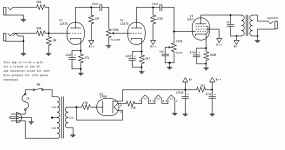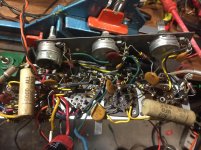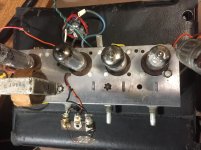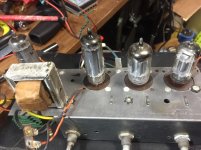All American Four Amplifier
Looks like I'm a year or two late in this thread, but thought I'd share. I built a SE 50C5 amp as a gift for a friend in the UK when we met at the Dayton Hamvention.
It uses 12AT6 (x2) as the preamp, 50C5 output, and 35W4 rectifier. Undistorted output approaches 3 watts when feeding a 8-ohm non-inductive dummy load and measuring on my Hitachi scope. A 75 ohm resistor eats up the remainder of the series heater string voltage.
The amp is powered through a 120/240 / 120 isolation transformer, and since this amp is destined for the UK, it is wired for 240V.
Plenty of volume for bedroom or living room, and eases into distortion at moderate volume.
Looks like I'm a year or two late in this thread, but thought I'd share. I built a SE 50C5 amp as a gift for a friend in the UK when we met at the Dayton Hamvention.
It uses 12AT6 (x2) as the preamp, 50C5 output, and 35W4 rectifier. Undistorted output approaches 3 watts when feeding a 8-ohm non-inductive dummy load and measuring on my Hitachi scope. A 75 ohm resistor eats up the remainder of the series heater string voltage.
The amp is powered through a 120/240 / 120 isolation transformer, and since this amp is destined for the UK, it is wired for 240V.
Plenty of volume for bedroom or living room, and eases into distortion at moderate volume.
Attachments
Re: All American Four Amplifier
I'd be interested to know how you are getting 3W out of a single 50c5. I have a stereo SE in the queue maybe i can pick up a few tips.
dave
Cephus said:Undistorted output approaches 3 watts when feeding a 8-ohm non-inductive dummy load
I'd be interested to know how you are getting 3W out of a single 50c5. I have a stereo SE in the queue maybe i can pick up a few tips.
dave
You can squeeze a little more power out of the 50c5 by raising the plate voltage to 150-160v and run the screens around 90v. Others here on the forum have suggested they are actually more linear when run like this.
My best advice for you is to ditch the 50C5 -- it's a horrible sounding tube. I know from experience. It sounds terrible for cleans and even worse in distortion.
It is possible, however, to mail all your weird tubes to a wholesaler and receive store credit to buy some tubes you do want.
There are a lot of great choices:
6DQ6: Horizontal deflection VT -- May very well make an excellent audio final. George (Tubelab) has used these for guitar amps. $7
Triode/pentode tubes include: 6JW8, 12AL8 $2
Inexpensive DHT tubes include: 6J6 $2.25, 3A5 $4.30, and 6AK5 $4.60
6EM7 ($6) is a high-mu low-mu dual triode designed to be a single-tube amp.
It may actually have enough gain for guitar.
http://www.the-planet.org/6EM7.html
It is possible, however, to mail all your weird tubes to a wholesaler and receive store credit to buy some tubes you do want.
There are a lot of great choices:
6DQ6: Horizontal deflection VT -- May very well make an excellent audio final. George (Tubelab) has used these for guitar amps. $7
Triode/pentode tubes include: 6JW8, 12AL8 $2
Inexpensive DHT tubes include: 6J6 $2.25, 3A5 $4.30, and 6AK5 $4.60
6EM7 ($6) is a high-mu low-mu dual triode designed to be a single-tube amp.
It may actually have enough gain for guitar.
http://www.the-planet.org/6EM7.html
Why not try a hybrid amp ?
It will be much cheaper than a true valve amp.
Personally I use a valve pre amp with a 450WRMS MOSFET amplifier and it sounds good.
It will be much cheaper than a true valve amp.
Personally I use a valve pre amp with a 450WRMS MOSFET amplifier and it sounds good.
Have you looked at the current Fender Vibro Champ?
This is a 5W class A tube amp with SS front end at a very reasonable price. I haven't played one myself, but I recently built a 5W SE amp with a Jensen speaker and Accutronics reverb tank. In the end it cost 25% more than the Fender and cost a lot of effort. 'Course I had some fun building it but when I saw the Fender (afterwards) I really thought twice.
w
This is a 5W class A tube amp with SS front end at a very reasonable price. I haven't played one myself, but I recently built a 5W SE amp with a Jensen speaker and Accutronics reverb tank. In the end it cost 25% more than the Fender and cost a lot of effort. 'Course I had some fun building it but when I saw the Fender (afterwards) I really thought twice.
w
Looks like I'm a year or two late in this thread, but thought I'd share. I built a SE 50C5 amp as a gift for a friend in the UK when we met at the Dayton Hamvention.
It uses 12AT6 (x2) as the preamp, 50C5 output, and 35W4 rectifier. Undistorted output approaches 3 watts when feeding a 8-ohm non-inductive dummy load and measuring on my Hitachi scope. A 75 ohm resistor eats up the remainder of the series heater string voltage.
The amp is powered through a 120/240 / 120 isolation transformer, and since this amp is destined for the UK, it is wired for 240V.
Plenty of volume for bedroom or living room, and eases into distortion at moderate volume.
I realize that it's been quite awhile, but is there any chance that you still have the schematic for this amplifier? I would really like to make this amplifier.
Thanks,
Nicholas G.
Hi,
It's not. Fred Nachbuar knew that, so do experienced DIYer's 🙂
You can use most any tube. You don't even need to build it at the correct phase of the moon while the chassis is held by virgins, like the audiophiles would have you believe 😉
Unless you want bar room filling power, which you have 6L6's for, a single ended 50C5 will do nice into that AA5 OPT. You'll get about a watt and one amp I have here that pushes a watt into a Weber 8" AlNiCo, that's plenty for practise or a family/friends jam.
Power transformer..... the 50C5 was designed to run off rectified line voltage, so it's a low voltage tube (160-180V). You just need an isolation for safety. If you do the 50C5 SE with your AA5 OPT, a 15VA bathroom shaver isolation transformer can work. They were ripped out of houses upgrading to the GFCI type and can be found in some thrist stores for a buck.
Use it to power the heater too and use a dropping resistor in your filament string.
Can't find a little isolation tranny? PM me and I'll find one.
Mr. Leadbelly... there 😎
Cheers!
Any chance you could lead me to a isolation transformer? I would really appreciate it. I'm currently building a mono amp with the 35w4, (2) 12au6, and a 50c5, all running off of the mains. It's called a AA4, a "all AA5 radio amplifier" I already have all the parts, all that I need is a cheap transformer.
Thanks,
Nicholas
The transformer I used is a 50VA Triad N-68X isolation transformer. It is available for $11.20 from Mouser.
In addition to allowing 120v / 240v primary option, the heftier transformer also has enough capacity so the series wired heaters can also be on the isolated side.
Joe
In addition to allowing 120v / 240v primary option, the heftier transformer also has enough capacity so the series wired heaters can also be on the isolated side.
Joe
The transformer I used is a 50VA Triad N-68X isolation transformer. It is available for $11.20 from Mouser.
In addition to allowing 120v / 240v primary option, the heftier transformer also has enough capacity so the series wired heaters can also be on the isolated side.
Joe
Thanks Joe, I ordered 2. Are you saying to hook the secondary up to the mains, then run the heaters and B+ voltages from the separate primary (now secondaries)? Thanks,
Nicholas
Thanks Joe, I ordered 2. Are you saying to hook the secondary up to the mains, then run the heaters and B+ voltages from the separate primary (now secondaries)? Thanks,
Nicholas
Yes, that's the idea. Because otherwise, the heaters string would pose a danger, too.
Old thread resurrection here; 'curious if a p-p 50C5 ever came to pass?
I ask, as I have a late-50's "mystery chassis" already most of the way there...and I sure could use some ID-Assistance!:
It is a 50C5 (push-pull <!>), four tube...but not the typical SE/12AX7 type ala RCA "RS-158" chassis: This has the a 12AV6 up front, but some (unidentifiable looks like "25X7" yet worn off) other tube apparently providing phase-splitting before the p-p 50C5's. There's an iso-trans, selenium rectifier and apparently dropping resistor in the series heater chain. It has been suggested that it might actually BE a 12AX7, and I'm just fixated on the nearly erased tube branding...
iCloud
I'd love guidance on the mystery chassis, as well as a model/schematic assistance. I've scoured the web for a week for similar topologies - and I'm a better than average Google'r - but the RS-15x series seems the closest. I'd hate to have to guess, based on series heater v'drops and pinout swag'ing. My goal, as with the O-P, is to convert to small guitar amp.
Thanks in advance!
I ask, as I have a late-50's "mystery chassis" already most of the way there...and I sure could use some ID-Assistance!:
It is a 50C5 (push-pull <!>), four tube...but not the typical SE/12AX7 type ala RCA "RS-158" chassis: This has the a 12AV6 up front, but some (unidentifiable looks like "25X7" yet worn off) other tube apparently providing phase-splitting before the p-p 50C5's. There's an iso-trans, selenium rectifier and apparently dropping resistor in the series heater chain. It has been suggested that it might actually BE a 12AX7, and I'm just fixated on the nearly erased tube branding...
iCloud
I'd love guidance on the mystery chassis, as well as a model/schematic assistance. I've scoured the web for a week for similar topologies - and I'm a better than average Google'r - but the RS-15x series seems the closest. I'd hate to have to guess, based on series heater v'drops and pinout swag'ing. My goal, as with the O-P, is to convert to small guitar amp.
Thanks in advance!
Attachments
Last edited by a moderator:
curious if a p-p 50C5 ever came to pass
It's not finished yet, but here is an unusual design that uses mosfets to drive the 50C5's into AB2. The power amp stage is still being developed, and the preamp stages haven't been started on yet. The unusual feature of this one is that it squeezes 20 watts out of a pair of 50C5's with HiFi levels of distortion. I will continue to work on it as time allows. (first three pictures)
B+ is about 350 volts, screen grids are at 140 volts. It has passed my "leave it running at full power overnight to see what happens" test with no damage. I set it to exactly 20 watts, where it made just under 3% THD with a slight hint of clipping on the bottom half of the wave. It was making 20.04 watts at 3.1% THD the next morning.
This evolved from this little amp that made 3 watts from a pair of 32ET5's on 170 volts of B+. They will make about 15 watts per pair on 350 volts and sound better than the 50C5s for cranked to 11 guitar. (next 4 pictures + schematic)
Attachments
-
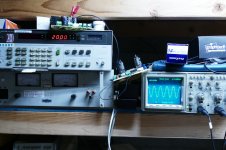 P3730057_x.jpg737.3 KB · Views: 111
P3730057_x.jpg737.3 KB · Views: 111 -
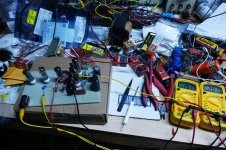 P3730053_x.jpg195.3 KB · Views: 137
P3730053_x.jpg195.3 KB · Views: 137 -
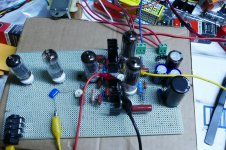 P3730052_x.jpg976.5 KB · Views: 133
P3730052_x.jpg976.5 KB · Views: 133 -
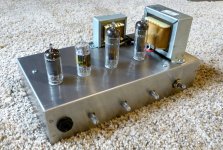 Chassis_1_x.jpg601 KB · Views: 90
Chassis_1_x.jpg601 KB · Views: 90 -
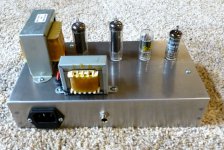 Chassis_2_x.jpg544 KB · Views: 89
Chassis_2_x.jpg544 KB · Views: 89 -
 Board_Transformers_x.jpg599.2 KB · Views: 87
Board_Transformers_x.jpg599.2 KB · Views: 87 -
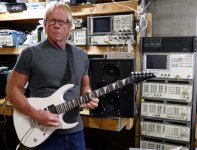 NewGuitar_x.jpg862.3 KB · Views: 101
NewGuitar_x.jpg862.3 KB · Views: 101 -
GTA_4T_11-04.pdf22.8 KB · Views: 112
Outstanding! Will be eagerly following the progress 🙂.
I was taken by the "opportunities" with this chassis/tiny-layout, and fully anticipate going to DC-heaters, boosted B+ (but nowhere near your levels <!>).
'Good hunting, sir!!
I was taken by the "opportunities" with this chassis/tiny-layout, and fully anticipate going to DC-heaters, boosted B+ (but nowhere near your levels <!>).
'Good hunting, sir!!
It's not finished yet, but here is an unusual design that uses mosfets to drive the 50C5's into AB2. The power amp stage is still being developed, and the preamp stages haven't been started on yet. The unusual feature of this one is that it squeezes 20 watts out of a pair of 50C5's with HiFi levels of distortion. I will continue to work on it as time allows. (first three pictures)
B+ is about 350 volts, screen grids are at 140 volts. It has passed my "leave it running at full power overnight to see what happens" test with no damage. I set it to exactly 20 watts, where it made just under 3% THD with a slight hint of clipping on the bottom half of the wave. It was making 20.04 watts at 3.1% THD the next morning.
This evolved from this little amp that made 3 watts from a pair of 32ET5's on 170 volts of B+. They will make about 15 watts per pair on 350 volts and sound better than the 50C5s for cranked to 11 guitar. (next 4 pictures + schematic)
I have a puny P-P transformer used with a pair of 35L6's, not quite the current density of a 50C5 Heater but probably more than the OT can take. I will have to measure the ratio on it some day. Might make for a 2-3W medium gain amp.
I was wondering about the overdrive characteristics of a Mosfet driven AB2 amp. The output tube is not shutting things down as 0V is approached, what is the limiting factor that says 'overdrive' what limits the output?
what is the limiting factor that says 'overdrive' what limits the output?
The limiting factor in many push pull amps is often not the plate dissipation, it's the screen grid. That is the case with the 50C5. I set up one of my Universal Driver boards (mosfets to drive the grids of the output tubes) with variable power supplies and ran a bunch of different tubes up to their breaking points just to find their limits.
I pushed a pair of 1940's 6L6GA's to 110 watts into a 3300 ohm load on 500 volts. They just sat there cranking out this much power for several minutes without any unusual glow on any internal parts. Going beyond 110 watts however, resulted in a tube arc blasting the cathode resistor in half. The tubes survived and lived on for more testing. At the same power 110+ watt level, another tube arc, and another blown resistor.
The 50C5 gets the glowing grid syndrome somewhere between 30 and 40 watts per pair on 340 volts into 6600 ohms depending on which tubes I tested (Sylvania, RCA or GE).
Most of the 50C5's that I tested didn't show ANY red plate in a dark room until 13 to 15 watts of dissipation per tube, so I arbitrarily set my limit at 10 watts.
The screen grid spec is 1.25 watts which seems to be the norm for other tubes of the same size with a HOT 7.5 watt heater. I would not venture too far beyond this for any continuous or high duty cycle operation like a cranked guitar amp.
To get max power from 20 watts worth of plate dissipation, you need to maximize efficiency. AB2 operation and a carefully chosen load impedance are used here to squeeze big watts from little tubes.
Here is the power output data for two tubes (but I didn't note which was which) with all the critical tube conditions noted. One pair of tubes stayed in spec to 30 watts. They will indeed run all night at that level. The others will not. The screen grid goes over 1.25 watts at about 27 watts of power output.
Both sets, and all the others that I have tested will run happily at 20 watts. All hit clipping right at 30 watts. At this point the THD and the screen grid current go up abruptly. running them continuously in clipping WILL fry them......So how do we make a cranked guitar amp?
The 32ET5 is pretty much the same tube, except it has a 3.2 watt heater. Since there are less watts of heat in the cathode, you can burn more in the plate for the same total heat inside the glass. I pushed them to 14 watts of plate dissipation. Under the same conditions as the 50C5, I hit the brick wall in the same place. At 30 watts output the plate dissipation was 9.5 watts and G2 was over spec at 1.6 watts. Attempting to go further produced 80+ mA of screen current, and a bright glowing grid.
We know that you can reduce G2 dissipation by attracting more electrons to the plate, so I set the plate supply at 400 volts. This allowed 35 watts of output at 13.4 watts of plate dissipation and 1.25 watts of screen dissipation. More drive makes 40 watts with nothing glowing in a dark room, but the screen grids were burning 1.8 watts. Pushing to 45 watts brought on glow in screen and plate.
The little guitar amp I made previously SOUNDED better with 32ET5's in it because the wimpy cathode produced a softer clip. The 50C5's were almost transistor like with a sawed off top and bottom on the sine wave. These tests were done with the screen grid tied directly to a regulated power supply.....stick a resistor in series and everything changes.
The small guitar amp that I was playing in the picture is still my go to amp for most guitar playing. At this moment it's the only working amp I have except a Chinese MESA Boogie clone that will blow you out of the basement with 120 watts.
When I was tweaking out that little amp I wound up with 32ET5's in AB1 on 170 volts. There is a 2.7 K resistor in series with both (paralled) screens. The entire preamp runs on the screen grid side of that resistor, so it gets about 155 volts at low volume, and drops to about 140 volts cranked. This limits the power output and saves the screen grids, which are abused harder at the low B+ voltage. I like the little amp, so I don't want to mess with it. That's why I'm working on a new one.
I haven't yet decided whether the new guy will get 50C5's or 32ET5's. I will try both when the preamp gets worked out and chose then. Note the 32ET5 and its companion tubes are all 100 mA heaters. This will cost a little in power output, but 20 watts is easily achievable with both. The 50C5 and it's friends need 150 mA. The issue might come down to what will run on a Triad N-68X.
Attachments
- Home
- Live Sound
- Instruments and Amps
- 50c5 push-pull for guitar?

